Education in the USA Nazhuova Bota SHFA —

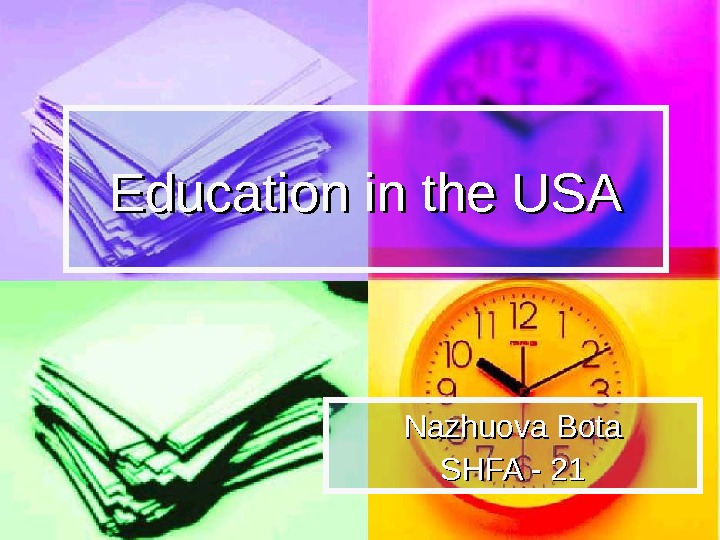

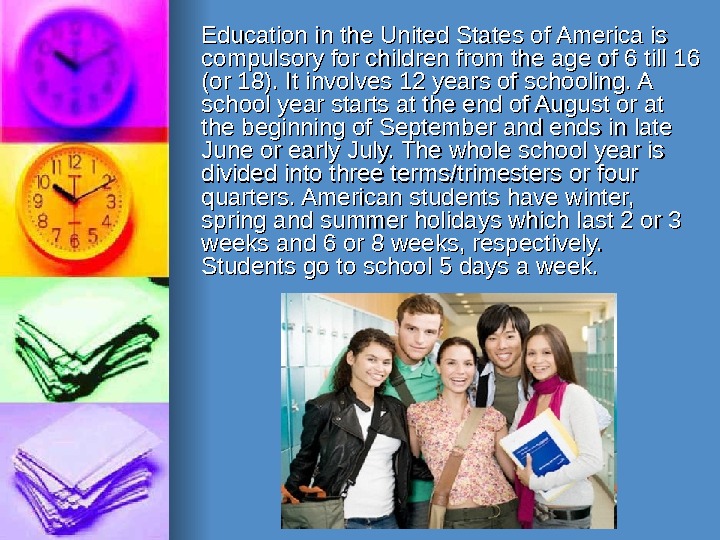

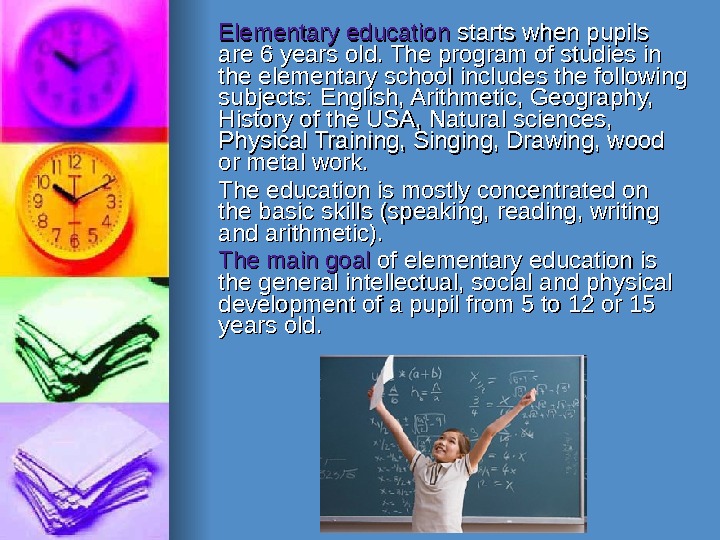
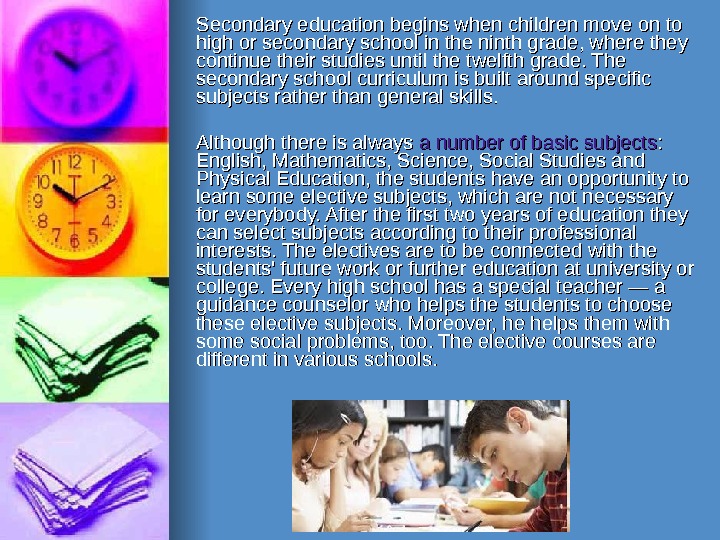
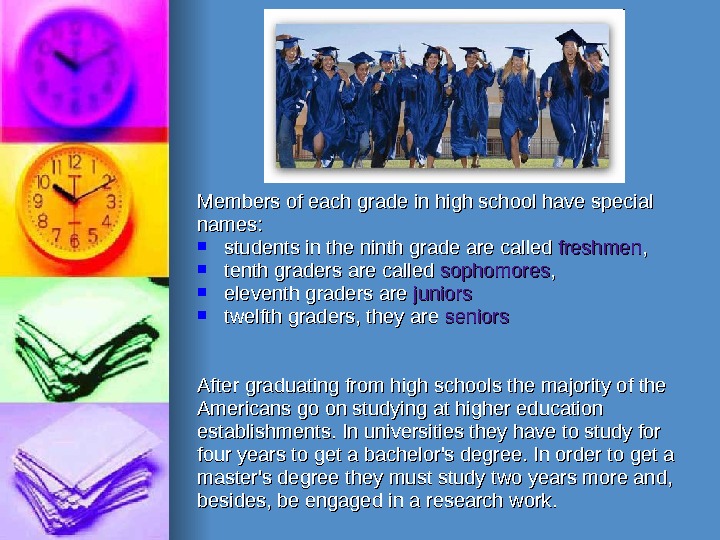

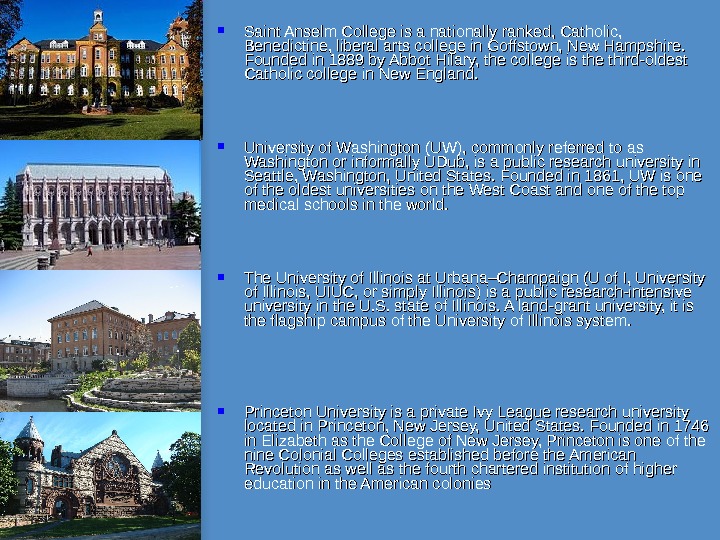
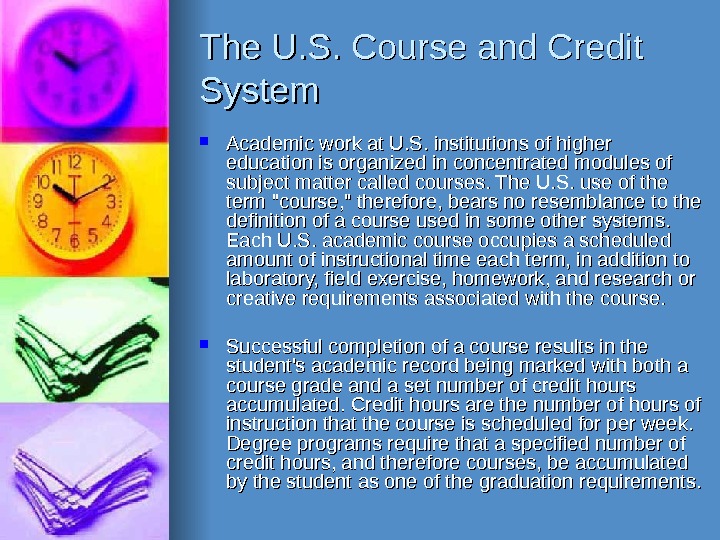

- Размер: 2.8 Mегабайта
- Количество слайдов: 11
Описание презентации Education in the USA Nazhuova Bota SHFA — по слайдам
 Education in the USA Nazhuova Bota SHFA —
Education in the USA Nazhuova Bota SHFA —
 The American system of school education differs from the systems in other countries. There are state public schools, private elementary schools and private secondary schools. Public schools are free and private schools are fee-paying. Each state has its own system of public schools.
The American system of school education differs from the systems in other countries. There are state public schools, private elementary schools and private secondary schools. Public schools are free and private schools are fee-paying. Each state has its own system of public schools.
 Education in the United States of America is compulsory for children from the age of 6 till 16 (or 18). It involves 12 years of schooling. A school year starts at the end of August or at the beginning of September and ends in late June or early July. The whole school year is divided into three terms/trimesters or four quarters. American students have winter, spring and summer holidays which last 2 or 3 weeks and 6 or 8 weeks, respectively. Students go to school 5 days a week.
Education in the United States of America is compulsory for children from the age of 6 till 16 (or 18). It involves 12 years of schooling. A school year starts at the end of August or at the beginning of September and ends in late June or early July. The whole school year is divided into three terms/trimesters or four quarters. American students have winter, spring and summer holidays which last 2 or 3 weeks and 6 or 8 weeks, respectively. Students go to school 5 days a week.
 The American education system consists of 3 basic components: 1. 1. Elementary 2. 2. Secondary 3. 3. Higher education There is also such a notion as preschool education. At the age of 4 or 5 children just get acquainted with the formal education in a nursery school. The preschool education program aims to prepare children for elementary school through playing and help them to acquire the experience of association. It lasts for one year. Then they go to the first grade (or grade 1).
The American education system consists of 3 basic components: 1. 1. Elementary 2. 2. Secondary 3. 3. Higher education There is also such a notion as preschool education. At the age of 4 or 5 children just get acquainted with the formal education in a nursery school. The preschool education program aims to prepare children for elementary school through playing and help them to acquire the experience of association. It lasts for one year. Then they go to the first grade (or grade 1).
 Elementary education starts when pupils are 6 years old. The program of studies in the elementary school includes the following subjects: English, Arithmetic, Geography, History of the USA, Natural sciences, Physical Training, Singing, Drawing, wood or metal work. The education is mostly concentrated on the basic skills (speaking, reading, writing and arithmetic). The main goal of elementary education is the general intellectual, social and physical development of a pupil from 5 to 12 or 15 years old.
Elementary education starts when pupils are 6 years old. The program of studies in the elementary school includes the following subjects: English, Arithmetic, Geography, History of the USA, Natural sciences, Physical Training, Singing, Drawing, wood or metal work. The education is mostly concentrated on the basic skills (speaking, reading, writing and arithmetic). The main goal of elementary education is the general intellectual, social and physical development of a pupil from 5 to 12 or 15 years old.
 Secondary education begins when children move on to high or secondary school in the ninth grade, where they continue their studies until the twelfth grade. The secondary school curriculum is built around specific subjects rather than general skills. Although there is always a number of basic subjects : : English, Mathematics, Science, Social Studies and Physical Education, the students have an opportunity to learn some elective subjects, which are not necessary for everybody. After the first two years of education they can select subjects according to their professional interests. The electives are to be connected with the students’ future work or further education at university or college. Every high school has a special teacher — a guidance counselor who helps the students to choose these elective subjects. Moreover, he helps them with some social problems, too. The elective courses are different in various schools.
Secondary education begins when children move on to high or secondary school in the ninth grade, where they continue their studies until the twelfth grade. The secondary school curriculum is built around specific subjects rather than general skills. Although there is always a number of basic subjects : : English, Mathematics, Science, Social Studies and Physical Education, the students have an opportunity to learn some elective subjects, which are not necessary for everybody. After the first two years of education they can select subjects according to their professional interests. The electives are to be connected with the students’ future work or further education at university or college. Every high school has a special teacher — a guidance counselor who helps the students to choose these elective subjects. Moreover, he helps them with some social problems, too. The elective courses are different in various schools.
 Members of each grade in high school have special names: students in the ninth grade are called freshmen , , tenth graders are called sophomores , , eleventh graders are juniors twelfth graders, they are seniors After graduating from high schools the majority of the Americans go on studying at higher education establishments. In universities they have to study for four years to get a bachelor’s degree. In order to get a master’s degree they must study two years more and, besides, be engaged in a research work.
Members of each grade in high school have special names: students in the ninth grade are called freshmen , , tenth graders are called sophomores , , eleventh graders are juniors twelfth graders, they are seniors After graduating from high schools the majority of the Americans go on studying at higher education establishments. In universities they have to study for four years to get a bachelor’s degree. In order to get a master’s degree they must study two years more and, besides, be engaged in a research work.
 The National Government gives no direct financial aid to the institutions of higher education. Students must pay a tuition fee. This creates a financial hardship for some people. Many of the students have to work to pay their expenses. Americans place a high value on education. That’s why Kennedy said, «Our progress as a nation can be no swifter than our progress in education».
The National Government gives no direct financial aid to the institutions of higher education. Students must pay a tuition fee. This creates a financial hardship for some people. Many of the students have to work to pay their expenses. Americans place a high value on education. That’s why Kennedy said, «Our progress as a nation can be no swifter than our progress in education».
 Saint Anselm College is a nationally ranked, Catholic, Benedictine, liberal arts college in Goffstown, New Hampshire. Founded in 1889 by Abbot Hilary, the college is the third-oldest Catholic college in New England. University of Washington (UW), commonly referred to as Washington or informally UDub, is a public research university in Seattle, Washington, United States. Founded in 1861, UW is one of the oldest universities on the West Coast and one of the top medical schools in the world. The University of Illinois at Urbana–Champaign (U of I, University of Illinois, UIUC, or simply Illinois) is a public research-intensive university in the U. S. state of Illinois. A land-grant university, it is the flagship campus of the University of Illinois system. Princeton University is a private Ivy League research university located in Princeton, New Jersey, United States. Founded in 1746 in Elizabeth as the College of New Jersey, Princeton is one of the nine Colonial Colleges established before the American Revolution as well as the fourth chartered institution of higher education in the American colonies
Saint Anselm College is a nationally ranked, Catholic, Benedictine, liberal arts college in Goffstown, New Hampshire. Founded in 1889 by Abbot Hilary, the college is the third-oldest Catholic college in New England. University of Washington (UW), commonly referred to as Washington or informally UDub, is a public research university in Seattle, Washington, United States. Founded in 1861, UW is one of the oldest universities on the West Coast and one of the top medical schools in the world. The University of Illinois at Urbana–Champaign (U of I, University of Illinois, UIUC, or simply Illinois) is a public research-intensive university in the U. S. state of Illinois. A land-grant university, it is the flagship campus of the University of Illinois system. Princeton University is a private Ivy League research university located in Princeton, New Jersey, United States. Founded in 1746 in Elizabeth as the College of New Jersey, Princeton is one of the nine Colonial Colleges established before the American Revolution as well as the fourth chartered institution of higher education in the American colonies
 The U. S. Course and Credit System Academic work at U. S. institutions of higher education is organized in concentrated modules of subject matter called courses. The U. S. use of the term «course, » therefore, bears no resemblance to the definition of a course used in some other systems. Each U. S. academic course occupies a scheduled amount of instructional time each term, in addition to laboratory, field exercise, homework, and research or creative requirements associated with the course. Successful completion of a course results in the student’s academic record being marked with both a course grade and a set number of credit hours accumulated. Credit hours are the number of hours of instruction that the course is scheduled for per week. Degree programs require that a specified number of credit hours, and therefore courses, be accumulated by the student as one of the graduation requirements.
The U. S. Course and Credit System Academic work at U. S. institutions of higher education is organized in concentrated modules of subject matter called courses. The U. S. use of the term «course, » therefore, bears no resemblance to the definition of a course used in some other systems. Each U. S. academic course occupies a scheduled amount of instructional time each term, in addition to laboratory, field exercise, homework, and research or creative requirements associated with the course. Successful completion of a course results in the student’s academic record being marked with both a course grade and a set number of credit hours accumulated. Credit hours are the number of hours of instruction that the course is scheduled for per week. Degree programs require that a specified number of credit hours, and therefore courses, be accumulated by the student as one of the graduation requirements.
 Thank you for your attention
Thank you for your attention

